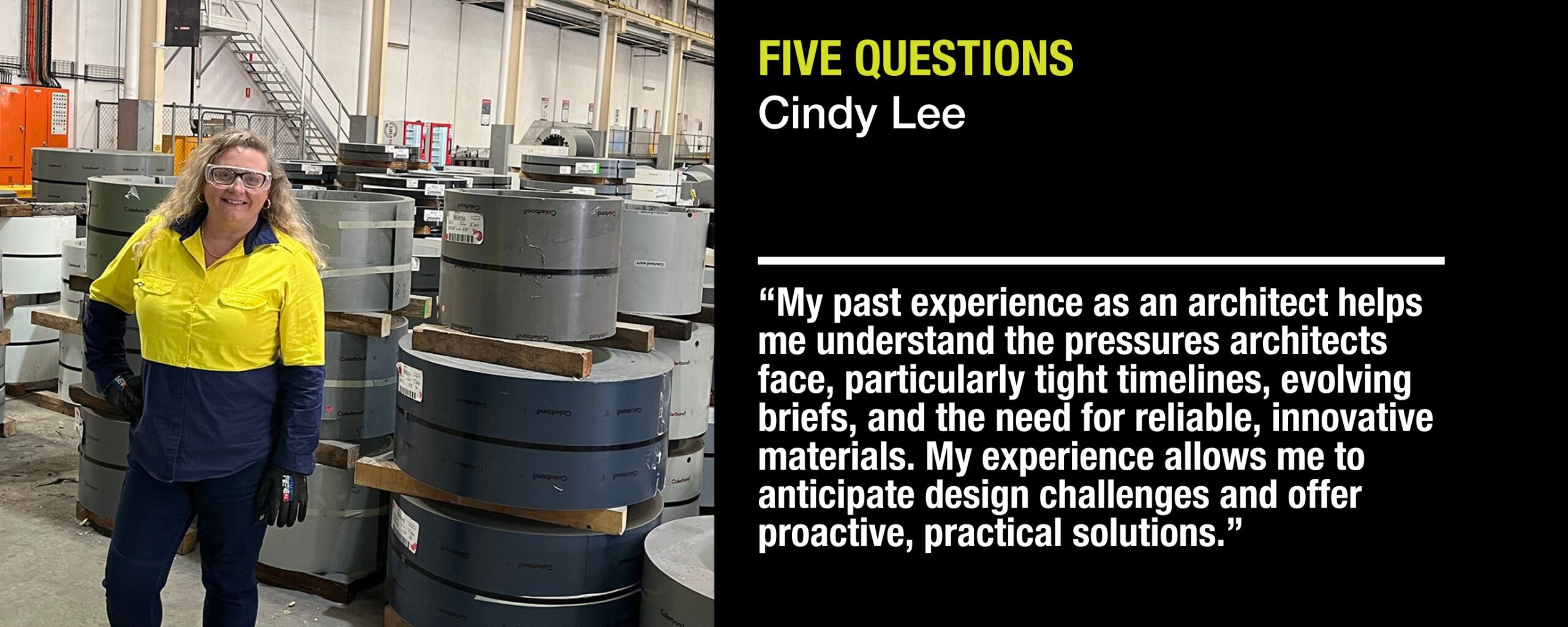From design to delivery

Architect turned specifications specialist, Cindy Lee bridges the gap between design and delivery in her role at Stratco. Here she shares insights on the company’s evolution, the shifting challenges of practice, and how early collaboration with suppliers can help architects realise their vision.
1. What was the genesis of Stratco and what does your role involve?
Stratco is a family-owned sheet metal company that started in Adelaide in 1948 and expanded into the other states and territories over the years. We are a roll former that specialises in roofing / wall cladding / patios / sheds / fencing. While we still have traces of that initial sheet metal capability we have developed into a multi-disciplinary company with a national footprint. I think the strength of Stratco is we have remained a customer-focused business at numerous levels. Our range of clients includes everyone from the large multinational construction company to business owners, professional tradesmen, and that homeowner needing assistance with a garden shed.
As an Architectural and Specifications Representative, I act as a bridge between Stratco factories, the trades and the architectural community. My role involves supporting architects from concept through to specification, ensuring that the Stratco products specified are not only fit for purpose but also elevate the design intent. A typical day might include studio visits, presenting CPD sessions to design teams, prototyping solutions, sample deliveries, help with detailing and specifications, and collaborating with our inhouse engineering and manufacturing teams. Every day is different, but the common thread is collaboration and problem-solving.
2. How does your past experience as an architect inform your current role?
My experience as an architect helps me understand the pressures architects face, particularly tight timelines, evolving briefs, and the need for reliable, innovative materials. My experience allows me to anticipate design challenges and offer proactive, practical solutions. I live vicariously through the projects I support. I’m invested in helping architects realise their vision, and I approach every interaction as a peer, not a salesperson. I know what it’s like to be on the other side of the table, and that empathy shapes how I engage, which is with respect, curiosity, and a genuine desire to contribute to amazing outcomes.
3. What are the major changes you have seen over your time in the construction industry?
I graduated in 2003, but I had worked in architectural practices while I was studying, so it’s been a while. The most significant changes I have noticed have been in the digital space, the response to environmental factors, and project delivery models. Computer modelling has changed how we design and coordinate projects. A big thing that I notice when I visit architectural offices nowadays is that there aren’t any drawing boards in sight. There’s a stronger focus on lifecycle performance, material transparency, and environmental impact. The rise of prefabrication, modular systems, and integrated supply chains has also changed how we build. Clearly there have also been shifts in labour markets, cost structures, and project delivery models.
Throughout it all, the need for trusted relationships and clear communication has remained constant.
4. What are the main challenges for the architecture profession? Where are the opportunities?
In the short term, architects are navigating increasingly complex regulatory environments, coupled with the pressure to deliver high-quality design outcomes within constrained budgets and accelerated timelines. The prevalence of value engineering often challenges the integrity of design intent, requiring architects to be both creative and pragmatic.
Looking ahead, the profession faces profound shifts driven by climate, rapid urbanisation, and the integration of emerging technologies such as AI, digital fabrication, and smart materials. These forces are reshaping not only how we design but also how we think about the built environment’s role in society.
At the same time, there’s an urgent need to nurture the next generation of architects, ensuring that career pathways remain viable, inclusive and inspiring. Retaining talent means fostering environments where creativity, mentorship and purpose can thrive.
Yet, within these challenges lie remarkable opportunities. Adaptive reuse is gaining momentum as a sustainable design strategy, and community-led projects are redefining the architect’s role as a facilitator of social equity and cultural expression. Architects are uniquely equipped to lead interdisciplinary conversations about place-making, resilience, and the human experience. Our ability to synthesise complex systems into coherent, meaningful spaces is not just valuable, it’s essential.
5. What key advice would you give to architects about engagement with material suppliers like Stratco?
Engage early. The earlier you involve suppliers like Stratco, the more value we can add to the project – whether it’s constructability advice, material and profile selection, or compliance support. We can help avoid post-tender surprises and ensure specifications are accurate and up to date.
Stratco offers a wide range of solutions, from architectural cladding to structural steel and we’re here to collaborate, not just supply.
I encourage architects to treat me as part of the design team. I am invested in your success, and ready to support your vision with technical expertise, responsive service, and a genuine passion for design.
Cindy Lee is Queensland’s Architectural and Specifications Representative for Stratco’s Architectural Solutions division. With a foundation in architectural design and technical specification, Cindy has worked previously as an architect in both the public and private sectors to deliver projects ranging from residential to commercial scale. She now uses that experience to help other design professionals with detailing and material choice.
